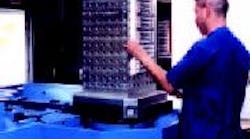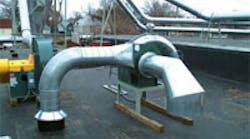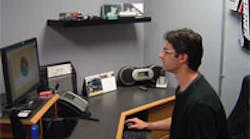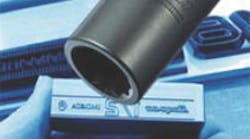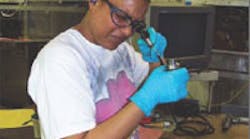The Mazak FH-5800's two-pallet shuttle lets Monterey load pallets while the machine is running.
MONTEREY MACHINING & MANUFACTURING INC., Castroville, Calif., serves the electronics industry. Productivity is paramount for the small company, which was formerly part of Synchronous Communications of San Jose, Calif., a provider of optical-networking technology.
"We started with two little no-name machining centers in the shipping area," says Rikk Jefferson, operations manager for Monterey. "Then we upgraded by adding two FH-5800 HMCs from Mazak — one 18 months ago and the second a year ago. On our old horizontal, we could pump out 40 parts in a 24-hr period. We can do the same on one of our new machines in 8 hr, a 3-to-1 increase in productivity."
That boost comes from a number of sources, primarily the 30-hp standard-spindle drive with 224 ft-lb torque, more than twice the horsepower of Monterey's previous horizontal. This is important because Monterey produces prototypes as well as part runs in the thousands on its equipment. "We average between 75% and 80% metal removal on most of our parts," says Jefferson. "We want them lightweight, yet sturdy. We use 6061-T6 aluminum, the same as that used for many aerospace parts."
One of the parts Monterey supplies Synchronous is an erbium-doped fiber amplifier (EDFA). Roughly the size of a shoebox, the EDFA is a two-piece module consisting of a bottom tray and a top piece available in a variety of sizes for use in fiberoptic networks.
Jefferson uses the Mazak's standard two-pallet shuttle system to load a tombstone while machining is being done on another. The four-sided tombstones have a bottom and top part on each side. "When the tombstone comes off, I have four complete parts and another tombstone ready to go," he says. "There's no stopping between runs."
The high-speed HMC further improves productivity by providing cutting rates up to 1,968 ipm for the X, Y, and Z axes, 0.7-G acceleration, 3.2-sec chip-to-chip automatic toolchange, and 1.8-sec table index per 90° of rotation. There are three spindle choices for various applications. "When we tried to do hogging on the other machines, it burned the spindle out," says Jefferson. "We called the machine manufacturer for help, and it referred us to the spindle manufacturer," he remembers. "Making this tray on our old equipment, the radii would be oblong or egg-shaped, not a true radius. Three-eighths would come out as one-half. Smoothness on the bottom would be less, and repeatability was off. Not so on the Mazak, which is right every time."
The shop went through a lot of end mills on its former machines. "When the tool would hit a corner on one of our parts, it just stayed at the same speed," remarks Jefferson. "This would make the tool flex and prevent it from cutting. The high-speed module on the Mazak Mazatrol control slows travel at the corner, leaving a higher-tolerance radii. The fastest our old machines could go is the starting point for our Mazaks."
Jefferson does all part prototyping and machine programming for Monterey, usually in EIA code, which posed no problem for the Mazatrol controls. "There are between 300 and 400 different parts we run," he says. "I use Mazatrol to incorporate all my EIAs into subroutines so I can activate the high-speed module when I want it. Not only do the radii come out better, the Mazatrol program means I don't have to go in and manually enter G-code after every single line of every subroutine in EIA."
The Mazak Tool Eye tool sensor also works with the Mazatrol control to reduce setup time, further increasing Monterey's productivity. The Tool Eye uses a special arm that automatically registers tool data in the CNC when the probe in the tool tip touches the part. Tool offset is registered automatically and stored for the next time a job is recalled. "I have certain programs that run on every single model we make," comments Jefferson. "All I have to do is tell the EIA to call up this subroutine and the Mazatrol already knows what tool to use and where it's at. Programming is faster, and setup is a breeze."
Machine diagnostics on the Mazatrol control also benefit Jefferson's shop. "With the other machines, when something went wrong, we had to break it down to investigate. With the Mazatrol, a screen pops up, tells you where the problem is, and how to fix it. You're back running a lot faster."
In addition to productivity benefits, the Mazaks have also helped Monterey improve part quality. "Essentially, we can make our parts better than the print calls for on our Mazak equipment," Jefferson says. "I just throw a block in, hit start, and walk away."
Mazak Corp.
FLORENCE, KY.
mazak.com
